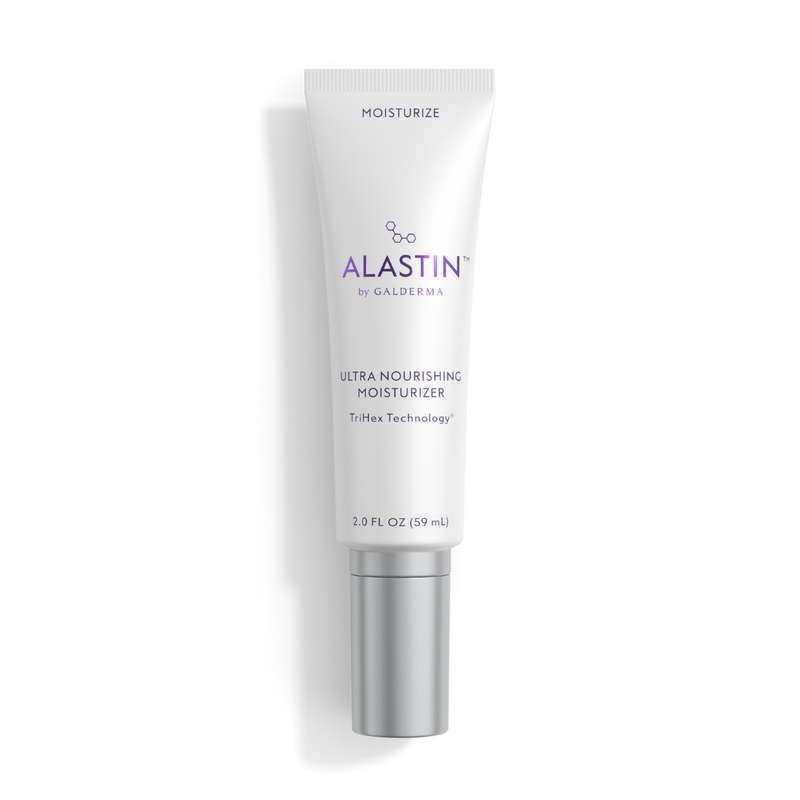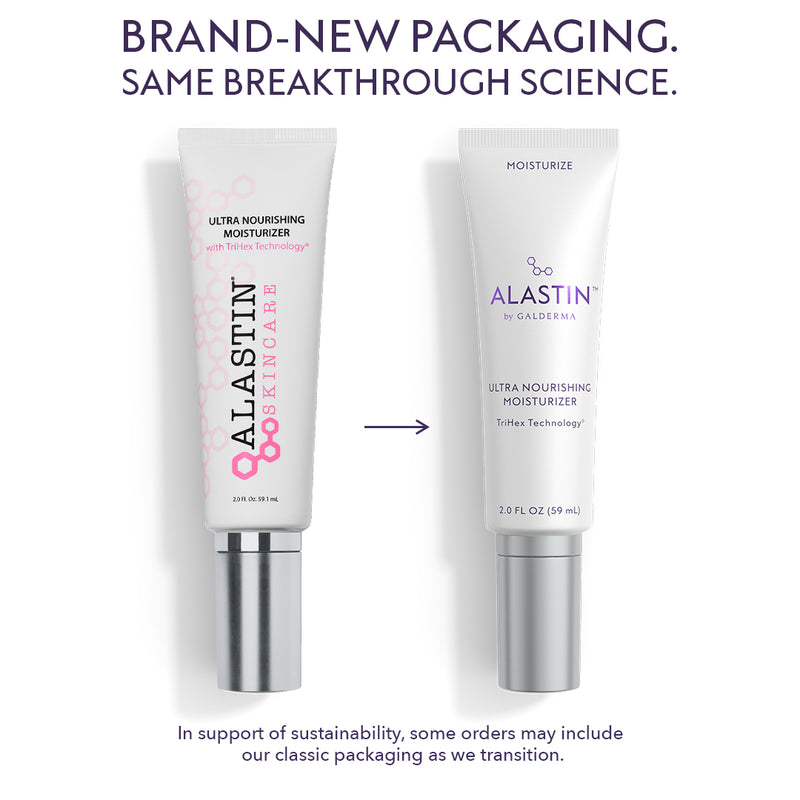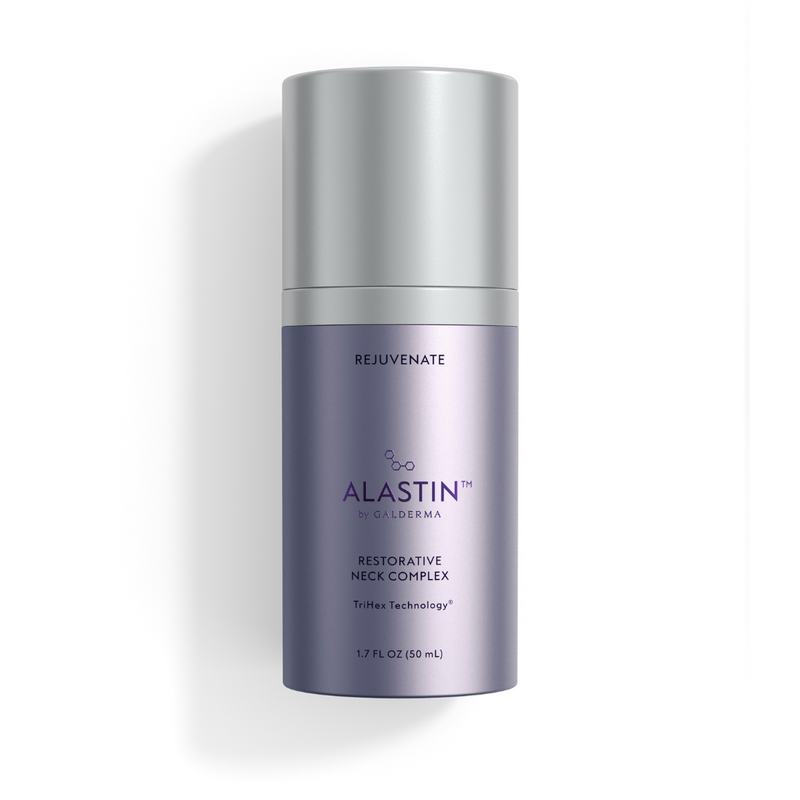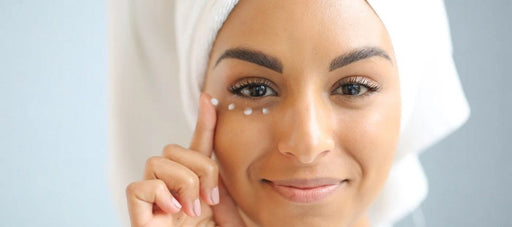You have no items in your bag
How To Get Rid Of Crepey Skin


When you think of crepe paper, you may think of brightly-colored party decorations, Mylar balloons, and pin the tail on the donkey. Crepey skin or "saggy skin;" however, may not put you in a party mood.
Crepey skin is just a part of getting older, wiser, and more fantastic. But let’s be honest, it’s not a particularly fun part of aging. However, crepey, aging skin can be improved. In this guide, you’ll find the most common causes of crepey skin, prevention methods, and the most effective anti-aging skincare along with a dermatologist’s recommendation for this skin concern.
Then you’ll really have something to celebrate.
What is Crepey Skin?
Crepey skin is skin that looks... well, like crepe paper. It’s thin, sagging, wrinkly skin that seems to have lost some of its natural elasticity. When you stretch the skin, it doesn’t settle back into place, but instead, hangs loosely. This kind of aging skin can form in areas that are commonly exposed to the sun above the knee, or in the under-arm flesh.
On a cellular level, crepey skin happens when the skin’s elastin fibers are damaged or are having difficulty repairing themselves. Elastin fibers are what allow skin cells to stretch and snap back to their normal shape. When damaged, it becomes harder for the skin to maintain its natural elasticity.
The most common crepey skin:
- crepey skin on neck
- crepey skin on hands
- crepey skin on arms
- crepey skin on face
What Causes Crepey Skin?
Luckily, scientists, researchers, and dermatologists have figured out how crepey, loose skin develops over time. There are a number of causes, including:
- Aging – Crepey skin is just another symptom of getting older. As your body ages, your skin produces less oil, collagen fibers, and elastin—all things necessary for taut, healthy-looking skin.
- Genetics – Crepey skin can be a bit like gray hair—some people just get it sooner than others. And there’s nothing to blame except for a genetic predisposition for early signs of aging.
- Dry skin – A lack of moisture in the skin can lead to severe dehydration on the cellular level. Dehydration hinders the dermatological systems from keeping skin healthy, plump, and firm1. Skin dryness on the face can enhance the appearance of neck wrinkles, fine lines, and other skin imperfections.
- Smoking or pollution – If you’ve ever seen photos of a smoker’s lungs, you can probably guess that cigarette smoke isn’t too kind to the skin either. Exposure to smoke and pollution can increase free radicals in your skin. Free radicals can damage elastin fibers, causing crepey, loose skin2.
- Rapid weight loss – When you lose a large amount of weight, your skin may feel loose and saggy. That’s because you’ve lost the weight that was keeping your skin taut, resulting in crepey skin texture.
The most common cause of crepey skin is something you are constantly exposed to: UV radiation. UV radiation is the blight of beauty, the scourge of skin health, and the most culpable of criminals when it comes to crepey skin. When the body has too much sun exposure, it absorbs UV radiation from the sun’s rays which causes sun damage to the skin. UV radiation permeates the skin and breaks down elastin fibers, resulting in loose, sagging skin or orange peel skin texture 3.
Here’s the good news: elastin fibers can heal ... but there’s a catch. Extended exposure to UV rays over time may permanently hinder the fibers’ ability to heal themselves and may even result in skin cancer.
The result? Crepey skin.
How To Prevent Crepey Skin
There are some parts of aging you really can’t do anything about. For instance, your mom’s advice seems smarter and smarter the older you got ... and some of the things you did as a teenager seem more and more ridiculous. Thankfully, crepey skin is something you cando something about.
Reduce crepey skin as you age by utilizing the following:
- Apply sunscreen – The American Association of Dermatology names UV radiation exposure as the most preventable cause of early skin damage and aging4. We get it, American Association of Dermatology, the sun is the enemy of youth! But there’s a UV radiation remedy that will fit perfectly in your purse, briefcase, or beach bag—sunscreen.
Sunscreen actually absorbs UV radiation before it can penetrate into your skin. Apply sunscreen everywhere that could be exposed to the sun, including your face, shoulders, neck, chest, arms, and hands. Do this daily, even when the skies are gray. Use a product that’s SPF 30 or greater and reapply every few hours.
Healthy Skin Tip: If skin health is your priority, you should use sunscreen every day. But you don’t have to use the greasy white stuff you slather on your kids before they jump in the pool. Elevate your definition of sunscreen with a reef-friendly, broad-spectrum, mineral tinted sunscreen with SPF 36. This lightweight and hydrating formula is a powerful sun protectant and an extremely effective makeup primer.
- Implement healthy eating habits – By eating a nutrient-rich diet, you can give your dermatological systems premium materials to prevent crepey skin.

-
Moisturize – Well-hydrated skin does not “crepe” as easily as dehydrated skin. Use moisturizers daily on your face, neck, chest, arms, and hands to help keep your skin plump and stretchy. A daily moisturizer is an essential step in both your morning and night skin care routine.
Healthy Skin Tip: Find a moisturizer that fights crepey skin on multiple fronts. Moisturizers formulated with antioxidants will tackle free radicals before they can damage your elastin fibers. Add a healthy dose of peptides, the amino acids that promote collagen and elastin production, and you’ve got a powerful anti-crepe cocktail. You can find all of those ingredients in our Ultra Nourishing Moisturizer with TriHex Technology® for your face, TransFORM Body Treatment with TriHex Technology® for crepey skin on the body, and Restorative Neck Complex with TriHex Technology® is a neck cream for your neck and décolleté.
No matter where you are in the aging process, these methods are tried and true practices for all-around skin health. To maintain your skin’s vitality (or get some of it back), just practicing skin hydration, eating well, and for Pete’s sake, keep using sunscreen!
How to Get Rid of Crepey Skin
If you’re noticing a little crepey-ness creeping into your skin, there are treatment options available. Depending on the severity and circumstances of crepey skin, you may be able to restore some of the skin’s elasticity.
From the most extreme measures to the simplest, here are the top three ways you can get rid of crepey skin texture:
#1 Surgery – For those with excessive crepey skin, surgery can be an option. However, surgeons tend to reserve this procedure for individuals who have crepey skin as a result of serious weight loss. And just like any surgery, surgical tightening of crepey skin comes with serious risks5 , including:
- Scarring
- Excessive bleeding
- The buildup of fluid under the skin’s surface
- Damage to the muscles, nerves, or blood vessels
- Death of fatty tissues
Your doctor will give you the best advice on your situation and whether you should try a surgical solution for crepey skin.
#2 Non-surgical skin procedures – Skin tightening can be done without surgery. These treatments can be effective for up to a year6 .
- Ultrasound Therapy – Ultrasounds involve high-frequency sound waves to heat the skin. This encourages the skin’s collagen production for firmer, tighter skin.
- Radiofrequency Treatment – Similar to ultrasound therapy, radiofrequency treatments heat the skin using radio waves. The radiofrequency targets deeper layers of the skin to create firmer, smoother skin and promote the production of collagen.
- Dermal Fillers – Filler injections are injected into crepey skin to add volume to the skin and prevent sagging.
All of the treatments above involve a doctor’s visit, some recovery time, and occasional bruising, redness, and numbness. The results can last between three months and a year and are most effective when supplemented with a good medical grade skin care regimen.
#3 Medical Grade Skincare Products – Painless and extremely effective, medical-grade skincare products are reviewed and approved by healthcare professionals and can help take the crepe out of your skin. These products contain higher concentrations of key ingredients and can be purchased through a medical professional or on their website, so it saves a trip to the office. With consistent use, you can see continuous results over time (without ever having to get poked, injected, or near a scalpel).
The only downside? Finding the best cream for crepey skin can be like finding a four-leaf clover in a clover field—which is why it’s always good to ask an expert and look for products backed by science.
What Do Dermatologists Recommend for Crepey Skin?
When it comes to the best neck firming cream and other crepey skin products, dermatologists across the country have two recommendations: ALASTIN Restorative Neck Complex for the neck and décolleté, and award-winning TransFORM Body Treatment for areas below the neck!
Dermatologist Brandon Kirsch told HuffPost Alastin's Restorative Neck Complex is "ideal for helping skin that’s aging, has dark spots or is tissue-paper thin. It helps increase skin hydration and supports the production of new, healthy elastin and collagen."
Dendy E. Engelman, M.D. states, “The latest trend for contracting muscles is CoolTone ($500 per treatment), a device that can treat your abdomen, butt, and thighs; expect to undergo four sessions within two weeks. New body-care formulas can help boost the results of your procedure. ALASTIN’s TransFORM Body Treatment can accelerate the body’s natural fat-removal process and support new healthy collagen production 7 .”

Anaheim, CA dermatologist, Dr. Kimberly Jerdan recommends ALASTIN Restorative Neck Complex in NewBeauty’s “Ultimate Guide to Better Skin.” And she isn’t alone. This unique formula is the crepey skin-fix pick of Dr. Heather Downes8 from Illinois. Texas-based doctor, Dr. Suneel Chilukuri had this to say about ALASTIN’s Restorative Neck Complex:
"...ALASTIN's Restorative Neck Complex is both an excellent topical treatment when used on its own as a part of an ongoing skin care routine, and is also appropriate to pair with a variety of neck and décolleté rejuvenating procedures as an anti aging cream to provide additive benefits."9
We made sure that this was the best product for crepey skin by creating a formula packed with antioxidants and peptides to stimulate your body’s elastin and collagen production. And the results are undeniable.

Trust ALASTIN to Help You Reverse Crepey Skin
When it comes to preventing and reversing crepey skin, your skin health always comes first. From consistent sunscreen application to implementing effective anti-crepe formulas to support collagen depletion, you can help promote skin elasticity for years to come. And our team of experts is always available to help you find what you need to rejuvenate your skincare routine.
Sources:
1. Ferreira, Mandy, and Debra Sullivan. “Causes of and Treatments for Crepey Skin.” Healthline, Healthline, 11 July 2017, www.healthline.com/health/crepey-skin.
2. Sims, Maddy. “7 Ways Smoking Affects Your Skin, from Premature Aging to Increased Skin Cancer Risk.” Insider, Insider, 26 Dec. 2019, www.insider.com/how-smoking-affects-your-skin-aging-wrinkles-skin-cancer-risk-2019-12.
3. Mukherjee, Siddharth, et al. “Retinoids in the Treatment of Skin Aging: an Overview of Clinical Efficacy and Safety.” Clinical Interventions in Aging, Dove Medical Press, 2006, www.ncbi.nlm.nih.gov/pmc/articles/PMC2699641/
4. McDaniel, David H. “UV Photography Shows Hidden Sun Damage.” American Academy of Dermatology, 2020, www.aad.org/public/everyday-care/sun-protection/sun-damaged/hidden-sun-damage.
5. Grotter, Ana, and Catherine Hannan. “Is Arm Lift Right for You?” Healthline, Healthline, 25 Oct. 2017, www.healthline.com/health/cosmetic-surgery/brachioplasty#risks
6.Update on Tissue Tightening.” Edited by Michael H. Gold, The Journal of Clinical and Aesthetic Dermatology, Matrix Medical Communications, May 2010, www.ncbi.nlm.nih.gov/pmc/articles/PMC2922712/
7. The Best Face and Body Skin-Care Products for 2020.” Shape Magazine, https://www.shape.com/lifestyle/beauty-style/best-skin-care-products-2020?slide=33acb82f-5fb4-45ed-80a0-3bb82347a111#33acb82f-5fb4-45ed-80a0-3bb82347a111
8. Editors, NewBeauty. “The Ultimate Guide to Better Skin, Based on Your Age.” NewBeauty, 30 Apr. 2019, www.newbeauty.com/guide-to-better-skin-20s-30s-40s-50s-60s/
9.“ALASTIN SKINCARE® LAUNCHES RESTORATIVE NECK COMPLEX.” ALASTIN Skincare®, Inc., 22 Jan. 2018, alastin.com/blogs/press-release/alastin-skincare-launches-restorative-neck-complex.
$98.00
$158.00
$220.00











